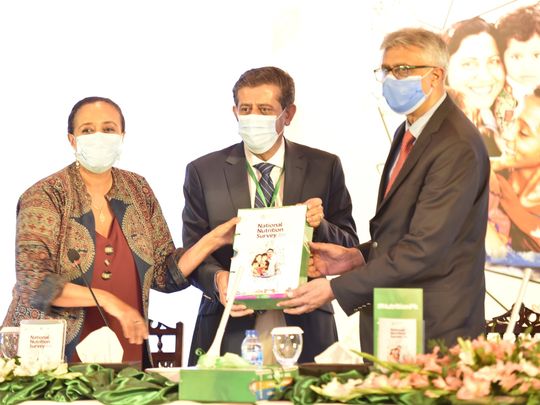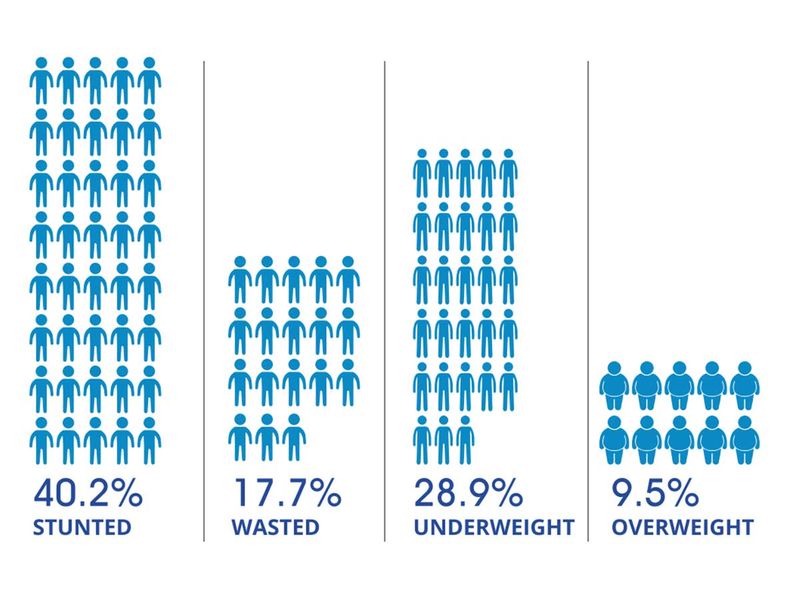
Islamabad: Nearly four out of 10 children under the age of five are stunted in Pakistan, says the latest National Nutrition Survey (NNS). The survey also found that 12.7% children have a functional disability in one of these six domains: seeing, hearing, walking, remembering, self-care and communication.
“The survey shows that nearly two out of every 10 children under five also suffer from wasting (low weight for height),” shared Dr Baseer Achakzai, Director Nutrition Programme at the Ministry of National Health Services (MHS) at the report launch in Islamabad. Child stunting refers to a child who is too short for his/ her age and is the result of chronic malnutrition.
The study also found out that one in every eight adolescent girls and one in every five adolescent boys are underweight, the report finds. More than half of Pakistani children are anaemic and 5.7 per cent are severely anaemic. Moreover, women of reproductive age also bear the burden of malnutrition and 14 per cent of them are undernourished while overweight and obesity level is increasing in urban women.

Largest ever nutrition survey of Pakistan
It is the largest ever nutrition survey conducted in the country that assessed the nutrition status of 115,500 households. The survey led by the ministry of NHS was funded by the United Kingdom government with technical support from UNICEF and carried out by Aga Khan University (AKU).
Priority area for government
Addressing the launching ceremony, Dr Faisal Sultan, Special Assistant to PM on National Health Services, said that the ministry is actively engaged in efforts to address the issue of malnutrition on the directions of Prime Minister Imran Khan. “Women and children in the country are far below the acceptable levels of nutrition and this alarming situation requires urgent attention,” he said. “For actionable plans and progress towards Sustainable Development Goals (SDG), food security and ending malnutrition, we have to develop district-specific and region-specific strategies. With a data set as comprehensive as NNS 2018, we are on the right track. Individuals and institutions’ partnerships on a micro and macro level will bear the fruits we have been striving for since decades,” Dr Sultan said.
Findings are a wake-up call
Aida Girma, the UNICEF representative in Pakistan, said the survey findings are a wake-up call as the country confronts a triple burden of malnutrition affecting young children, adolescents, pregnant and lactating women. “Nutrition in Pakistan requires high level attention and adequate funding to reduce mortality due to malnutrition and to ensure that every child reaches their full development potential in life.”
The results of the survey would help Pakistan in tackling the issue of malnutrition, said Deputy Director Development British High Commission Jim Carpy. He added that the UK would continue to work closely with Pakistan to improve maternal and child health, end preventable deaths besides ensuring adequate nutrition for all.
Highlights from the report:
Stunting: With 12 million children with a low height for age, stunting is a major problem in Pakistan. Stunting reduction is now a top national priority for the government. The national average is 40 per cent and the prevalence of stunting varies from 32 per cent in Islamabad Capital Territory to 48 per cent in Khyber Pakhtunkhwa.
Wasting: The prevalence of low weight for height among young children is continually on the rise from 8.6 per cent in 1997 to 17.7 per cent in 2018 – which is the highest rate of wasting in Pakistan’s history. Despite improvements in other socio-economic indicators, acute malnutrition remains in a state of nutrition emergency.
Underweight: With 28.9 per cent underweight children, the prevalence among kids under five years of age is high in all provinces and regions. The province of Sindh has the highest number of underweight children at 41.3 per cent.
Overweight: At least 9.5 per cent of the children under the age of five were overweight, according to the study.








